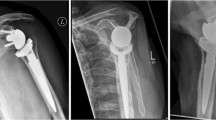Summary
Shoulder replacement has been shown to provide pain relief and improvement of shoulder function in patients with glenohumeral degenerative arthritis. This series involved 53 prostheses implanted in patients solely with primary osteoarthritis (OA) of the shoulder who had been reviewed clinically and radiologically. The purpose of this study was to evaluate mid-term results of an anatomically designed shoulder in a longitudinal survey.
Between 1993 and 2003 we implanted 41 total and 12 hemiprostheses. Preoperatively all patients were evaluated radiologically and clinically by using the Constant score (CS). Follow-up (Fup) examinations were performed after 6 months and then annually. The minimum Fup was 24 months.
After the first 6 months the CS increased significantly from 41.4 to 67.3 (P<0.001). During the following years these values remained stable for the CS-criteria pain, mobility and activity. Radiologically radiolucent lines were observed in 70% of the cases but there was no correlation with the clinical results (P<0.513). Two glenoid implants were changed for loosening and one for malpositioning. As a results the survival rate reached 95.1% after an average of 4.5 years.
In summary, shoulder arthroplasty for primary OA provides continuous and predictable midterm results. Radiolucent lines should be controlled but do not influence the clinical outcome yet.
Zusammenfassung
Bei fortgeschrittener Omarthrose besteht in aller Regel die Indikation zur endoprothetischen Versorgung mittels Hemi- oder Totalendoprothese. Ziel der vorliegenden Studie war eine prospektive Längsschnittuntersuchung zur Erfassung der klinischen und radiologischen Ergebnisse im zeitlichen Verlauf.
Eingeschlossen wurden 53 Patienten aus dem Zeitraum 1993–2003, bei denen 43x Totalprothesen und 12x Hemiprothesen implantiert wurden. Die Erfassung erfolgte prä- und postoperativ anhand von Röntgenaufnahmen und anhand des Constant scores (CS). Die Kontrollen wurden initial nach 6 Monaten und anschließend 1x jährlich durchgeführt. Der durchschnittliche Nachuntersuchungszeitraum betrug 4,5 Jahre.
Der CS stieg nach 6 Monaten und einem Jahr signifikant auf 67,3 bzw. 67,5 Punkte an (P<0,001). Hiermit verbunden war eine signifikante Abnahme der präoperativen Schmerzangaben (P<0,001) sowie eine signifikante Verbesserung der Schultergelenkbeweglichkeit. Beispielsweise konnte die durchschnittliche präoperative Flexion von 96,8° auf 145,1° verbessert werden. In 70 % der Fälle zeigten sich periprothetische Lysesäume, ohne dass diese Einfluss auf das klinische Ergebnis nahmen (P<0,513).
Zusammenfassend stellt die Schulterendoprothetik ein erfolgreiches Verfahren zur Behandlung fortgeschrittener Omarthrosen dar. Die klinischen und röntgenologischen Verläufe sind mittelfristig bei Überlebensraten von 95,1% nach 4,5 Jahren als relativ konstant anzusehen. Weitere Langzeituntersuchungen werden über die Revisionsraten, speziell von Seiten des Glenoides, zu entscheiden haben.
Similar content being viewed by others
Literatur
Bishop J, Flatow E (2005) Humeral head replacement versus total shoulder arthroplasty: Clinical outcomes – A review. J Shoulder Elbow Surg 14:141S–146S
Constant CR, Murley AH (1987) A clinical method of functional assessment of the shoulder. Clin Orthop 214:160–164
Edwards TB, Kadakia NR, Boulahia A, Kempf JF, Boileau P, Nemoz C,Walch G (2003) A comparison of hemiarthroplasty and total shoulder arthroplasty in the treatment of primary glenohumeral osteoarthritis: Results of a multicenter study. J Shoulder Elbow Surg 12:207–213
Kempf JF, Walch G, Lacaze F (1999) Results of shoulder arthroplasty in primary gleno-humeral osteoarthritis. In: Walch G, Boileau P (Hrsg.) Shoulder Arthroplasty. Springer Berlin-Heidelberg-New York, S. 204–210
Loew M, Rickert M, Schneider S, Heitkemper S (2005) Die Dezentrierung des Schultergelenkes als Spätfolge nach hemi- und totalendoprothetischem Gelenkersatz. Z Orthop 143:446–452
Mansat P, Mansat M, Bellumore Y, Rongieres M, Bonneville P (2002) Mid-term results of shoulder arthroplasty for primary osteoarthritis. Rev Chir Orthop Repar App Mot 88:544–552
Neer CS (1974) Replacement arthroplasty for glenohumeral arthritis. J Bone Joint Surg 56:1–13
Sperling JW, Cofield RH, Rowland CM (2004) Minimum fifteen-year follow-up of Neer hemiarthroplasty and total shoulder arthroplasty in patients aged fifty years or younger. J Shoulder Elbow Surg 13:604–613
Torchia ME, Cofield RH, Settergren CR (1997) Total shoulder arthroplasty with the Neer prosthesis: long-term results. J Shoulder Elbow Surg 6:495–505
Walch G, Badet R, Boulahia A, Khoury A (1999) Morphological study of the glenoid in primary osteoarthritis. J Arthroplasty 14:756–760
Author information
Authors and Affiliations
Corresponding author
Rights and permissions
About this article
Cite this article
Rickert, M., Heitkemper, S., Schneider, S. et al. Schulterendoprothetik bei primärer Omarthrose. Obere Extremität 1, 58–63 (2006). https://doi.org/10.1007/s11678-006-0005-2
Received:
Accepted:
Issue Date:
DOI: https://doi.org/10.1007/s11678-006-0005-2




